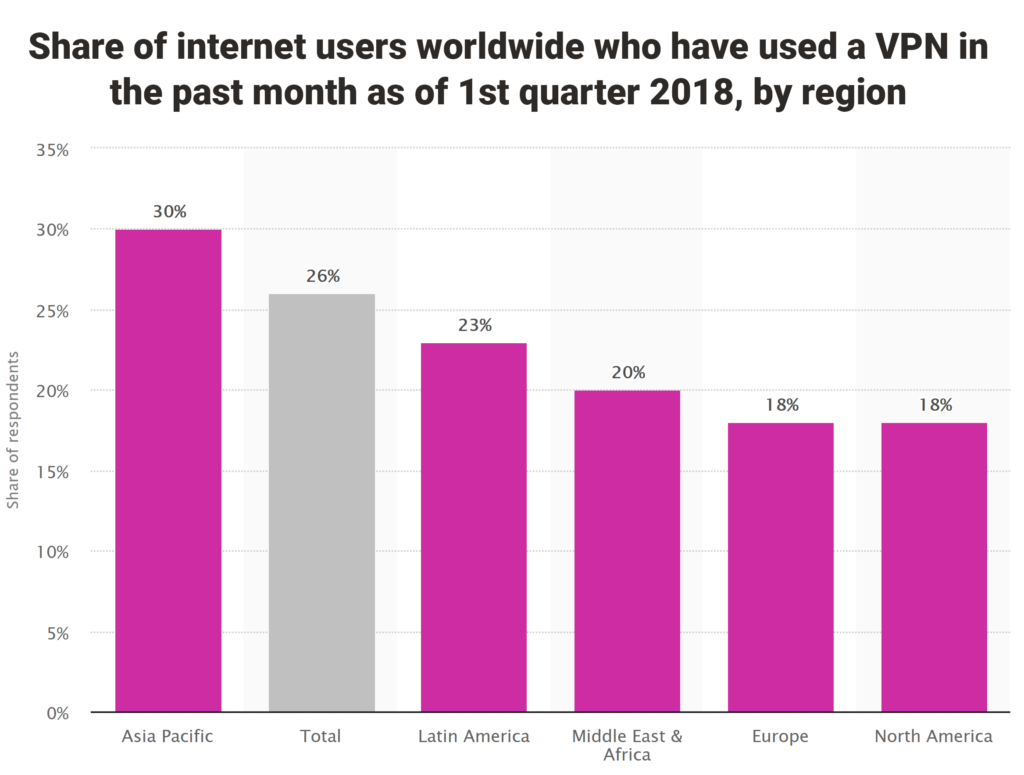
VPNs: why they matter for paid media plans
Understanding how VPN usage varies across markets can and should be used to shape your global media strategy and execution. The short version is this: VPN usage is increasingly popular, and impacts brands’ ability to accurately measure and analyse. And usage varies across markets. Using data to better gauge consumers’ behaviour in relation to ‘privacy’ (ad blocking, privacy settings and VPN usage) will help brands make more optimised decisions about which markets provide the best opportunity for paid media.
VPNs limit our ability to accurately analyse international digital marketing campaigns
As a starter, this statement from a leading VPN provider:
“Geo-targeting is when your physical location is determined and then used by Internet marketers to serve up ads that are relevant to where you’re located. When you’re on the web without a VPN, online advertisers know information about you, such as: IP address, ISP, organization, zip code, state or region, city and country.
But when you use VPNXXXXX, your real IP address becomes hidden behind an anonymous IP address, so online marketers, search engines and websites are all in the dark when it comes to your personal information. This allows you to avoid location identification, annoying ads, and unwanted marketing just by simply connecting to one of our secure servers.”
Now, this from Global Web Index:
“With leading brands worldwide relying on inaccurate information to guide their marketing strategies, many have winded up chasing phantom audiences, investing heavily in the wrong markets. One reputable UK publisher, for example, decided to set up a New York office and allocate a large portion of its budget to marketing in the U.S. based on inaccurate insights.
This represents tens of millions of sunken cost, signed off on an incorrect analytics report. Similarly, the majority of online advertising is geo-targeted which means many messages are failing to reach their target audiences.
The US today makes up less than 8% of the global internet population, but still represents 38% of digital ad spend. The internet users of fast growth markets like Brazil, Indonesia and India are losing out, and primarily due to the face that IP geo-targeting makes them invisible.”
While you digest, a quick re-cap on what a VPN typically does. See this from The Wirecutter:
“If you’re trying to leave as few tracks as possible online, a VPN can add an extra layer of privacy by preventing tracking based on your IP address (the unique identifier for your computer or home network that makes it possible for websites and services to send information back to you).
Large sites and platforms that trade in personal information, such as Google, track clicks, search terms, and other behaviour associated with each particular IP address, even if you aren’t logged in to an account on those sites. By changing your IP address with a VPN, and mingling your activity with that of potentially dozens or hundreds of other people using the same VPN server, you make it harder.”
Looks like using a VPN significantly decreases the accuracy of analytics, with more (negative) impact on accuracy as your need for granular analysis increases, particularly if you are optimizing based on location data e.g. for real time mobile campaigns. So how prevalent is VPN use?
According to Statista, the 2018 regional numbers look like this:
With per country breakdowns on % online population using VPNs as follows:
Global Web Index commentary indicates that:
“APAC leads by region, with almost a third of consumers located here using a VPN last month, and Indonesia leading at 44%. In fact, two thirds of the world’s VPN users are located in APAC.
This geographical pattern of usage has major implications for audience measurement. When using a VPN, digital consumers can be incorrectly geo-located by passive analytics, which can have major implications for website traffic measurement.
This could mean that some visitors to digital content services recorded from more established markets, like the U.S., are actually users in fast-growth markets.
Alongside high levels of device sharing and multi-device internet usage, VPN usage is leading to millions of “missing” internet users who are being misunderstood or overlooked entirely by passive data collection techniques – leading to a large chunk of ad spend being misdirected.”
Also note that globally, VPN use on mobile is almost level with use on desktop:
And that (concerningly for advertisers) VPN use is most popular amongst younger people:
.
Final thoughts – two distinct challenges for advertisers to consider
Across all markets, the use of ad blockers (as discussed in last week’s article) and VPNs create challenges for effective digital marketing, in relation to
- planning / forecasting (where ad block use should be factored into your forecasts and projections) and in relation to…
- …insight and analysis (where VPN use should be carefully considered in verifying accuracy of KPIs and of future investments based on estimated inaccuracy caused by VPN use).
As we can see from this review, known and significant differences in ad block and VPN use across international markets should be used to refine your approach to market selection.
 Matt Owen | Director, Oban International
Matt Owen | Director, Oban International
Oban International is the digital marketing agency specialising in international expansion. Our LIME (Local In-Market Expert) Network provides up to date cultural input and insights from over 80 markets around the world, helping clients realise the best marketing opportunities and avoid the costliest mistakes.



